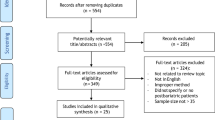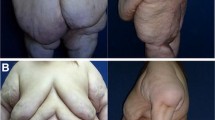Abstract
Background
With the increased popularity of bariatric surgery, the demand for body-contouring procedures is growing. Associated with these procedures are a number of complications due to different risk factors and patients’ characteristics. The aim of this study was to assess the outcome of body-contouring procedures and correlate it to possible risk factors.
Methods
The study included a collective of 112 patients who underwent 157 body-contouring procedures. Patients’ characteristics, risk factors, and complications have been recorded. Three groups were formed based on the type of surgical procedure to perform correlations of BMI, weight of resected tissue, and length of hospital stay using Spearman’s rank test. Correlations between patients’ risk factors and complication occurrence were analyzed with Fisher’s exact test.
Results
The most common procedure patients underwent was the classic abdominoplasty (n = 53). A significant correlation was found between preoperative BMI and weight of resected tissue in abdominoplasties (rho = 0.69), Fleur-de-Lis abdominoplasties (rho = 0.64), and body lifts (rho = 0.60). There was a significant correlation between weight of resected tissue and length of hospital stay (rho = 0.53) and preoperative BMI and length of hospital stay (rho = 0.4) as well. There was no significant correlation between patients’ comorbidities or smoking status and the postoperative complication rate. The mean weight of resected tissue was higher in patients with than without complications requiring surgical revision.
Conclusions
The relevance of risk factors commonly believed to have an influence on postoperative complications should be revised. The weight of resected tissue has an influence on complication.

Similar content being viewed by others
References
Spivak H, Hewitt MF, Onn A, et al. Weight loss and improvement of obesity-related illness in 500 U.S. patients following laparoscopic adjustable gastric banding procedure. Am J Surg. 2005;189(1):27–32.
Modarressi A, Balague N, Huber O, et al. Plastic surgery after gastric bypass improves long-term quality of life. Obes Surg. 2013;23(1):24–30.
Buchwald H, Avidor Y, Braunwald E, et al. Bariatric surgery: a systematic review and meta-analysis. JAMA. 2004;292(14):1724–37.
Gusenoff JA. Body contouring after massive weight loss. Clin Plast Surg. 2019;46(1):xi.
Aldaqal SM, Makhdoum AM, Turki AM, et al. Post-bariatric surgery satisfaction and body-contouring consideration after massive weight loss. N Am J Med Sci. 2013;5(4):301–5.
Balague N, Combescure C, Huber O, et al. Plastic surgery improves long-term weight control after bariatric surgery. Plast Reconstr Surg. 2013;132(4):826–33.
Smith OJ, Hachach-Haram N, Greenfield M, et al. Body contouring surgery and the maintenance of weight-loss following Roux-en-Y gastric bypass: a retrospective study. Aesthet Surg J. 2018;38(2):176–82.
Marek RJ, Steffen KJ, Flum DR, et al. Psychosocial functioning and quality of life in patients with loose redundant skin 4 to 5 years after bariatric surgery. Surg Obes Relat Dis. 2018;14(11):1740–7.
Zuelzer HB, Baugh NG. Bariatric and body-contouring surgery: a continuum of care for excess and lax skin. Plast Surg Nurs. 2007;27(1):3–13. quiz 14-5
Garcia Botero A, Garcia Wenninger M, Fernandez Loaiza D. Complications after body contouring surgery in postbariatric patients. Ann Plast Surg. 2017;79(3):293–7.
Beidas OE, Gusenoff JA. Common complications and management after massive weight loss patient safety in plastic surgery. Clin Plast Surg. 2019;46(1):115–22.
Neaman KC, Hansen JE. Analysis of complications from abdominoplasty: a review of 206 cases at a university hospital. Ann Plast Surg. 2007;58(3):292–8.
Parvizi D, Friedl H, Wurzer P, et al. A multiple regression analysis of postoperative complications after body-contouring surgery: a retrospective analysis of 205 patients: regression analysis of complications. Obes Surg. 2015;25(8):1482–90.
van der Beek ES, van der Molen AM, van Ramshorst B. Complications after body contouring surgery in post-bariatric patients: the importance of a stable weight close to normal. Obes Facts. 2011;4(1):61–6.
Colwell AS. Current concepts in post-bariatric body contouring. Obes Surg. 2010;20(8):1178–82.
Constantine RS, Davis KE, Kenkel JM. The effect of massive weight loss status, amount of weight loss, and method of weight loss on body contouring outcomes. Aesthet Surg J. 2014;34(4):578–83.
Bruschi S, Datta G, Bocchiotti MA, et al. Limb contouring after massive weight loss: functional rather than aesthetic improvement. Obes Surg. 2009;19(4):407–11.
Taylor J, Shermak M. Body contouring following massive weight loss. Obes Surg. 2004;14(8):1080–5.
Vico PG, De Vooght A, Nokerman B. Circumferential body contouring in bariatric and non-bariatric patient. J Plast Reconstr Aesthet Surg. 2010;63(5):814–9.
de Kerviler S, Husler R, Banic A, et al. Body contouring surgery following bariatric surgery and dietetically induced massive weight reduction: a risk analysis. Obes Surg. 2009;19(5):553–9.
Matarasso A. Traditional abdominoplasty. Clin Plast Surg. 2010;37(3):415–37.
Acarturk TO, Wachtman G, Heil B, et al. Panniculectomy as an adjuvant to bariatric surgery. Ann Plast Surg. 2004;53(4):360–6. discussion 367
Dellon AL. Fleur-de-lis abdominoplasty. Aesthet Plast Surg. 1985;9(1):27–32.
Lockwood TE. Transverse flank-thigh-buttock lift with superficial fascial suspension. Plast Reconstr Surg. 1991;87(6):1019–27.
Lockwood T. High-lateral-tension abdominoplasty with superficial fascial system suspension. Plast Reconstr Surg. 1995;96(3):603–15.
Lockwood T. Lower body lift with superficial fascial system suspension. Plast Reconstr Surg. 1993;92(6):1112–22. discussion 1123-5
Lockwood TE. Lower-body lift. Aesthet Surg J. 2001;21(4):355–70.
Mathes DW, Kenkel JM. Current concepts in medial thighplasty. Clin Plast Surg. 2008;35(1):151–63.
Lockwood TE. Fascial anchoring technique in medial thigh lifts. Plast Reconstr Surg. 1988;82(2):299–304.
Hurwitz DJ, Holland SW. The L brachioplasty: an innovative approach to correct excess tissue of the upper arm, axilla, and lateral chest. Plast Reconstr Surg. 2006;117(2):403–11. discussion 412-3
Lockwood T. Brachioplasty with superficial fascial system suspension. Plast Reconstr Surg. 1995;96(4):912–20.
Strauch B, Greenspun D, Levine J, et al. A technique of brachioplasty. Plast Reconstr Surg. 2004;113(3):1044–8. discussion 1049
Ziegler UE, Lorenz U, Daigeler A, et al. Modified treatment algorithm for pseudogynecomastia after massive weight loss. Ann Plast Surg. 2018;81(3):290–4.
Coon D, Gusenoff JA, Kannan N, et al. Body mass and surgical complications in the postbariatric reconstructive patient: analysis of 511 cases. Ann Surg. 2009;249(3):397–401.
Iglesias M, Ortega-Rojo A, Garcia-Alvarez MN, et al. Demographic factors, outcomes, and complications in abdominal contouring surgery after massive weight loss in a developing country. Ann Plast Surg. 2012;69(1):54–8.
Nemerofsky RB, Oliak DA, Capella JF. Body lift: an account of 200 consecutive cases in the massive weight loss patient. Plast Reconstr Surg. 2006;117(2):414–30.
Vastine VL, Morgan RF, Williams GS, et al. Wound complications of abdominoplasty in obese patients. Ann Plast Surg. 1999;42(1):34–9.
Gusenoff JA, Coon D, Nayar H, et al. Medial thigh lift in the massive weight loss population: outcomes and complications. Plast Reconstr Surg. 2015;135(1):98–106.
Greco 3rd JA, Castaldo ET, Nanney LB, et al. The effect of weight loss surgery and body mass index on wound complications after abdominal contouring operations. Ann Plast Surg. 2008;61(3):235–42.
Gusenoff JA, Coon D, Rubin JP. Implications of weight loss method in body contouring outcomes. Plast Reconstr Surg. 2009;123(1):373–6.
Modarressi A, Meia Ruegg E, Bezzola T, et al. Circular abdominoplasty after massive weight loss: is it a risky procedure? J Plast Reconstr Aesthet Surg. 2016;69(11):1497–505.
Reichenberger MA, Stoff A, Richter DF. Body contouring surgery in the massive weight loss patient. Chirurg. 2007;78(4):326–34.
Swedenhammar E, Stark B, Hallstrand AH, et al. Surgical training and standardised management guidelines improved the 30-day complication rate after abdominoplasty for massive weight loss. World J Surg. 2018;42(6):1647–54.
Bertheuil N, Chaput B, De Runz A, et al. The lipo-body lift: a new circumferential body-contouring technique useful after bariatric surgery. Plast Reconstr Surg. 2017;139(1):38e–49e.
Coon D, Michaels J, Gusenoff JA, et al. Hypothermia and complications in postbariatric body contouring. Plast Reconstr Surg. 2012;130(2):443–8.
Kokosis G, Coon D. Safety in body contouring to avoid complications. Clin Plast Surg. 2019;46(1):25–32.
Fischer JP, Wes AM, Serletti JM, et al. Complications in body contouring procedures: an analysis of 1797 patients from the 2005 to 2010 American College of Surgeons National Surgical Quality Improvement Program databases. Plast Reconstr Surg. 2013;132(6):1411–20.
Shermak MA, Chang D, Magnuson TH, et al. An outcomes analysis of patients undergoing body contouring surgery after massive weight loss. Plast Reconstr Surg. 2006;118(4):1026–31.
Manassa EH, Hertl CH, Olbrisch RR. Wound healing problems in smokers and nonsmokers after 132 abdominoplasties. Plast Reconstr Surg. 2003;111(6):2082–7. discussion 2088-9
Chaouat M, Levan P, Lalanne B, et al. Abdominal dermolipectomies: early postoperative complications and long-term unfavorable results. Plast Reconstr Surg. 2000;106(7):1614–8. discussion 1619-23
Author information
Authors and Affiliations
Corresponding author
Ethics declarations
The study was approved by the ethics committee of the University of Tübingen (project number 711/2013BO2).
Conflict of Interest
The authors declare that they have no conflict of interest.
Informed Consent Statement
This does not apply to the study. No identifying information is available in the article.
Additional information
Publisher’s Note
Springer Nature remains neutral with regard to jurisdictional claims in published maps and institutional affiliations.
Rights and permissions
About this article
Cite this article
Krauss, S., Medesan, R., Black, J. et al. Outcome of Body-Contouring Procedures After Massive Weight Loss. OBES SURG 29, 1832–1840 (2019). https://doi.org/10.1007/s11695-019-03773-z
Published:
Issue Date:
DOI: https://doi.org/10.1007/s11695-019-03773-z




